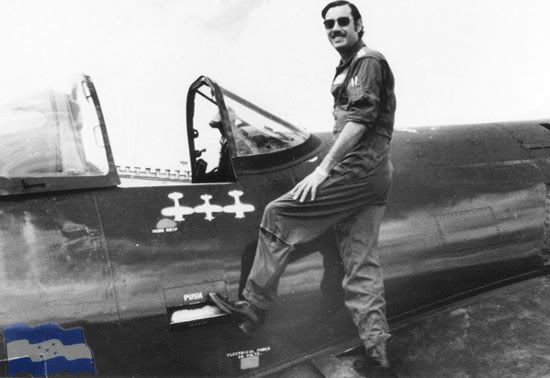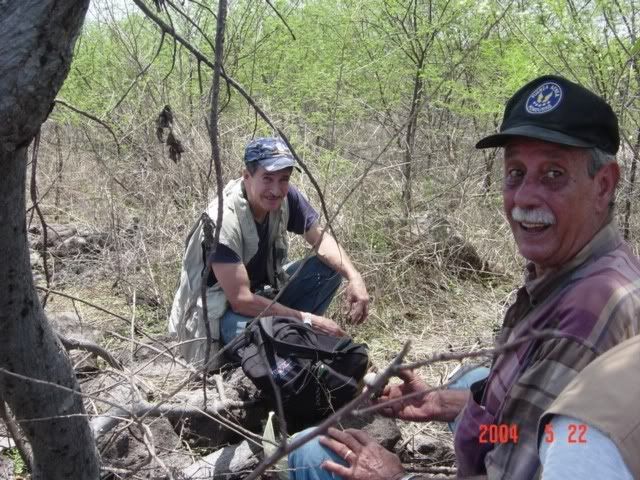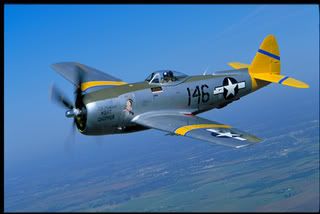Favorite Ace-in-a-Day Stories
Sun Oct 01, 2006 8:50 am
Any war, any air force: Which is your favorite ace-in-a-day story?
My personal favorite is from then Lt. Bob Stone, 318th FG, 333rd FS, at the time flying P-47N's off Ie Shima. The following narrative was written by CO Lt. Col. Harry McAfee (Some may note that the Captain Judge Wolfe mentioned, who bagged four on this same day, is also credited with being the first USAAF pilot to have downed an enemy aircraft with a HVAR on an earlier mission). Be sure to read all the way to the surprise ending.
With its insolent handful of P-47's the 318th was outfighting the enemy from Okinawa to Central Kyushu, goading him into the all-out defensive effort which came on June 10. When 35 Thunderbolts flew north that morning to protect Navy photographic Liberators, they found a reception party of 134 Zekes, Jacks, Tonys, Tojos and Georges. Few Thunderbolts were free to carry the battle to the Japanese. Most held their defensive screen to discourage any major attack on the photoplanes.
Of the 35 Thunderbolt pilots, only eight actually found targets for their guns. But these eight handed the Japanese a lacing which left the wreckage of 10 Zekes, six Jacks and one twin-engine bomber sprinkled from 30 to 50 miles north of Kyushu's Kagoshima Wan.
Captain Judge E. Wolfe bagged four that day to ran his total to nine and establish him as the Group's leading marksmen. But the hair raiser of all stories brought home that noon was the one told by Lieutenant Bob Stone.
Flying one of nine Thunderbolts in a diversionary sweep to suck Japanese defenders away from the photo planes he shot down two of seven Zekes encountered and destroyed by the formation 30 miles north of Kagoshima Wan. A few miles north the 318th pilots spotted 50 more Japanese fighters and climbed for altitude. Stone, whose induction system had been damaged on takeoff couldn't develop full power at high altitude and was maneuvering to attack a lone George down below when he sew 25 Zeros streaking down on his tail.
Stone went from 28,000 foot to the deck in one long screaming dive. He pulled out at the bush tops and streaked across country with two Japanese hot on his heels, the rest of the pack strung out behind. Part of the time, the belly of his Thunderbolt was less than three foot off the ground. The two leading Japanese were within 300 feet and firing as Stone nosed up to clear a low hummock and flash past the startled Japanese faces at the runway of Nittagahara Airfield. A twin-engine Betty bomber just leaving the ground, loomed squarely in his path.
Stone swerved left to dodge the Betty and at that moment became the 318th Fighter Group's fifth ace. His prop wash caught the two Japanese close behind him. They crashed together and, still together, plowed into the hapless Betty.
My personal favorite is from then Lt. Bob Stone, 318th FG, 333rd FS, at the time flying P-47N's off Ie Shima. The following narrative was written by CO Lt. Col. Harry McAfee (Some may note that the Captain Judge Wolfe mentioned, who bagged four on this same day, is also credited with being the first USAAF pilot to have downed an enemy aircraft with a HVAR on an earlier mission). Be sure to read all the way to the surprise ending.
With its insolent handful of P-47's the 318th was outfighting the enemy from Okinawa to Central Kyushu, goading him into the all-out defensive effort which came on June 10. When 35 Thunderbolts flew north that morning to protect Navy photographic Liberators, they found a reception party of 134 Zekes, Jacks, Tonys, Tojos and Georges. Few Thunderbolts were free to carry the battle to the Japanese. Most held their defensive screen to discourage any major attack on the photoplanes.
Of the 35 Thunderbolt pilots, only eight actually found targets for their guns. But these eight handed the Japanese a lacing which left the wreckage of 10 Zekes, six Jacks and one twin-engine bomber sprinkled from 30 to 50 miles north of Kyushu's Kagoshima Wan.
Captain Judge E. Wolfe bagged four that day to ran his total to nine and establish him as the Group's leading marksmen. But the hair raiser of all stories brought home that noon was the one told by Lieutenant Bob Stone.
Flying one of nine Thunderbolts in a diversionary sweep to suck Japanese defenders away from the photo planes he shot down two of seven Zekes encountered and destroyed by the formation 30 miles north of Kagoshima Wan. A few miles north the 318th pilots spotted 50 more Japanese fighters and climbed for altitude. Stone, whose induction system had been damaged on takeoff couldn't develop full power at high altitude and was maneuvering to attack a lone George down below when he sew 25 Zeros streaking down on his tail.
Stone went from 28,000 foot to the deck in one long screaming dive. He pulled out at the bush tops and streaked across country with two Japanese hot on his heels, the rest of the pack strung out behind. Part of the time, the belly of his Thunderbolt was less than three foot off the ground. The two leading Japanese were within 300 feet and firing as Stone nosed up to clear a low hummock and flash past the startled Japanese faces at the runway of Nittagahara Airfield. A twin-engine Betty bomber just leaving the ground, loomed squarely in his path.
Stone swerved left to dodge the Betty and at that moment became the 318th Fighter Group's fifth ace. His prop wash caught the two Japanese close behind him. They crashed together and, still together, plowed into the hapless Betty.
Robert "Shorty" Rankin - 61st FS, 56th FG, 8th AF
Sun Oct 01, 2006 9:03 am
This one is my favorite because I met Shorty in person and interviewed him for EAA's Timeless Voices of Aviation oral history program. On May 12, 1944 the 56th FG flew the first Zemke Fan, flying out ahead of the bomber stream and fanning out to catch EA unware. It worked, and Shorty knocked down 5 109s. You can hear the story at www.timelessvoices.org. Click on the video category "Military-WWII" and then scroll down through the names to "Rankin, Robert," then click "Play". You have to have a broadband connection to watch it though, as it is a large streaming file that would take all day with dialup.
Look forward to seeing what everyone else's favorites are.
Zack
Look forward to seeing what everyone else's favorites are.
Zack
Sun Oct 01, 2006 7:32 pm
Dan K wrote:
Different air services worldwide had different victory credit systems, however, a fighter ace is a generally accepted as a military pilot credited with shooting down five or more enemy aircraft.
Although the term “ace” may not be credited to Honduran Air Force pilot, Captain Fernando Soto Henríquez, on July 17, 1969 during the short conflict called the "100-Hour War" with neighboring El Salvador, he became a national hero when he downed three Salvadoran fighters (the only aerial victories ever recorded by a Central American air force) in Vought F4U-5N Corsair BuNo. 124715.
This war is often cited as the last occasion on which piston-engined fighters fought each other.
While strafing ground targets near the Honduras-El Salvador border, on his second mission of the day, Captain Soto got a call that one of his mates, Captain Francisco Zepeda Andino, who, with his guns jammed, had two Salvadoran Cavalier F-51 Mustangs on his tail. Captain Soto entered the fray quickly and let loose a burst of 20-mm gunfire. The Mustangs broke…one left and one right. He turned starboard inside one Mustang, fired three bursts and it instantly caught fire and dove into the ground. The pilot, Captain Douglas Vladimir Varela was killed after his parachute failed to deploy completely. Surprisingly, the Salvadoran pilots had engaged aerial combat without releasing the two 250-lb bombs each aircraft was carrying.
Later, on his third mission of the day, Captain Soto downed two Goodyear FG-1D Corsairs, the first one after a short burst, and the pilot, Captain Salvador Ceceña Amaya, was able to parachute to safety. In a hard fought, turning and diving dogfight, from 12,000 feet to about 9,000 feet, the second one exploded after two or three bursts. The pilot, Captain Guillermo Reynaldo Cortéz (considered to be the best Salvadoran fighter pilot) was killed instantly.
During a 2003 video-taped interview he granted me, retired Lt. Col. Soto mentions that Captain Cortéz may have forgotten to disengage the main tank pressure release, which may explain why the aircraft exploded.
I was fortunate enough to become Lt. Col. Soto's friend sometime in 1966, and was able to interview him several times. A very emotional one, in May 2004 when with a group of friends, we visited the site the Mustang crash site (in Honduran territory), about a mile from the Honduras-El Salvador border.
For the record, the two FG-1Ds were shot down over Salvadoran territory.
Sadly, Fernando Soto Henríquez passed away on June 25, 2006, at age 67. He did not only serve his country with distinction, or excell as a commercial pilot ... he was a true gentleman.
Photo credits:
FAH collection
Esteban Hernández Peña

[IMG]http://i110.photobucket.com/albums/n82/AAF_1945/Fotos%20FSH/ExpedicinCerroLaGrifaEH6.jpg[/
Any war, any air force: Which is your favorite ace-in-a-day story?
Different air services worldwide had different victory credit systems, however, a fighter ace is a generally accepted as a military pilot credited with shooting down five or more enemy aircraft.
Although the term “ace” may not be credited to Honduran Air Force pilot, Captain Fernando Soto Henríquez, on July 17, 1969 during the short conflict called the "100-Hour War" with neighboring El Salvador, he became a national hero when he downed three Salvadoran fighters (the only aerial victories ever recorded by a Central American air force) in Vought F4U-5N Corsair BuNo. 124715.
This war is often cited as the last occasion on which piston-engined fighters fought each other.
While strafing ground targets near the Honduras-El Salvador border, on his second mission of the day, Captain Soto got a call that one of his mates, Captain Francisco Zepeda Andino, who, with his guns jammed, had two Salvadoran Cavalier F-51 Mustangs on his tail. Captain Soto entered the fray quickly and let loose a burst of 20-mm gunfire. The Mustangs broke…one left and one right. He turned starboard inside one Mustang, fired three bursts and it instantly caught fire and dove into the ground. The pilot, Captain Douglas Vladimir Varela was killed after his parachute failed to deploy completely. Surprisingly, the Salvadoran pilots had engaged aerial combat without releasing the two 250-lb bombs each aircraft was carrying.
Later, on his third mission of the day, Captain Soto downed two Goodyear FG-1D Corsairs, the first one after a short burst, and the pilot, Captain Salvador Ceceña Amaya, was able to parachute to safety. In a hard fought, turning and diving dogfight, from 12,000 feet to about 9,000 feet, the second one exploded after two or three bursts. The pilot, Captain Guillermo Reynaldo Cortéz (considered to be the best Salvadoran fighter pilot) was killed instantly.
During a 2003 video-taped interview he granted me, retired Lt. Col. Soto mentions that Captain Cortéz may have forgotten to disengage the main tank pressure release, which may explain why the aircraft exploded.
I was fortunate enough to become Lt. Col. Soto's friend sometime in 1966, and was able to interview him several times. A very emotional one, in May 2004 when with a group of friends, we visited the site the Mustang crash site (in Honduran territory), about a mile from the Honduras-El Salvador border.
For the record, the two FG-1Ds were shot down over Salvadoran territory.
Sadly, Fernando Soto Henríquez passed away on June 25, 2006, at age 67. He did not only serve his country with distinction, or excell as a commercial pilot ... he was a true gentleman.
Photo credits:
FAH collection
Esteban Hernández Peña

[IMG]http://i110.photobucket.com/albums/n82/AAF_1945/Fotos%20FSH/ExpedicinCerroLaGrifaEH6.jpg[/
Sun Oct 01, 2006 7:35 pm

Mon Oct 02, 2006 10:36 am
Mon Oct 02, 2006 12:34 pm
So is Perdomo's your favoite story or favorite paint job? 
